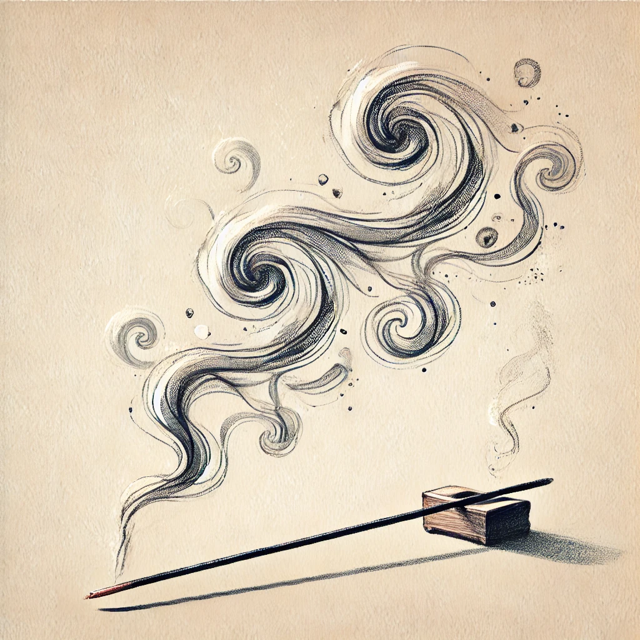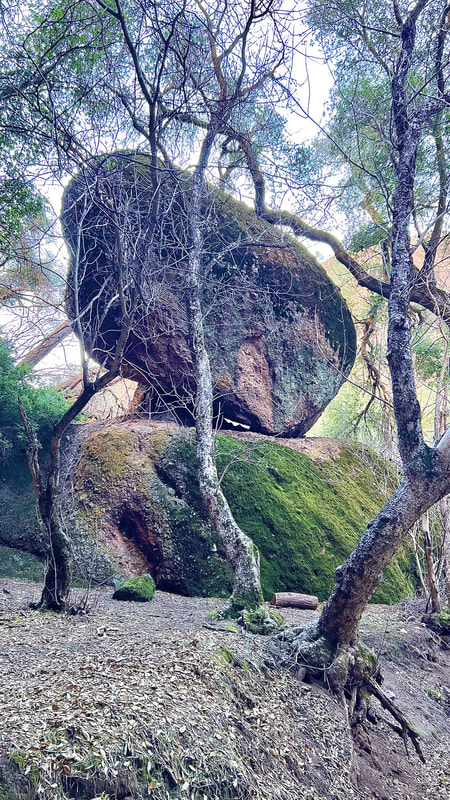|
The smoke rises, weightless, free, A silent dancer upon the breeze. Unrushed, unbound, it twists and sways, A fleeting form, yet never fades. I watch—no, I feel—its flow, The same force moves through me, I know. No difference, no divide, no line, Just energy shifting, shape divine. The smoke sees me as I see it, No boundary drawn, no moment split. The watcher and the watched are one, A dance of light, a song unsung. And when the incense burns to ash, Its body fades, but not its path. It rises, merges with the air, Returning home, still everywhere. So too, we live, so too, we burn, A flicker bright, then we return. Not lost, not gone—just something new, The source awaits, the source is you. Imagine watching incense burn. The solid stick gradually turns to ash, releasing a delicate stream of smoke that twists and turns, rising, dispersing, and finally fading into the air. It’s a quiet, mesmerizing process—one that mirrors our own existence more than we realize.
In that moment, as you watch the smoke drift, there is an unspoken truth: you are observing it, and it is observing you. Not with eyes, but with presence. This is the essence of consciousness—awareness experiencing itself in infinite forms. The Observer and the Observed One of the most profound realizations in both spirituality and quantum physics is that observation changes reality. In quantum mechanics, the Observer Effect suggests that particles behave differently when they are being watched. This means that consciousness itself plays a role in shaping reality. Now, consider this: if you, as consciousness, are observing the smoke, and the smoke is also an expression of the same universal energy, then what separates you from it? In truth, nothing. The same energy flows through both of you, just expressed in different forms simultaneously. The incense burns, transforms, and eventually disappears—but its essence doesn’t vanish. It simply returns to its source, just as we do. Energy Never Dies—It Transforms Science tells us that energy cannot be created or destroyed; it only changes form. This is known as the First Law of Thermodynamics. The smoke that rises from the incense does not cease to exist—it merges back into the air, becoming part of something greater. Now, apply this to yourself. Our bodies, like the incense stick, burn through time. Eventually, the form dissolves, but the energy—the consciousness that we are—does not disappear. It returns to the source, to the infinite field of existence, only to take on new forms again. This understanding changes how we see life and death. Instead of fearing the end, we recognize it as a transformation, not a disappearance. How This Awareness Can Change Our Daily Lives 1. It Shifts Our Perspective on Death – Just as smoke is never truly lost, neither are we. Death is not the end, but a return. This brings peace in moments of loss. 2. It Deepens Our Presence – When we see that everything is a fleeting expression of the same energy, we cherish the present moment more. We become less attached to form and more connected to the essence of life. 3. It Reminds Us of Our Interconnectedness – If the same energy flows through everything, then separation is an illusion. The tree, the wind, the people around us—all are different expressions of the same universal presence. 4. It Encourages Flow and Acceptance – Smoke moves freely, adapting to whatever space it enters. When we adopt this fluidity in life, we resist less, suffer less, and align ourselves with the natural rhythm of existence. Conclusion The incense burns out, but the smoke does not die. It returns to its source, waiting to take shape again. And so do we. By recognizing that we are both the observer and the observed, we awaken to a deeper truth: consciousness is infinite, ever-changing, and always present. Life is not about clinging to form, but about embracing the beauty of transformation. Next time you watch smoke rise, pause for a moment. Feel its movement. See its freedom. And in it, recognize yourself.
0 Comments
Have you ever wondered how something as solid as a table or a rock can be made up of tiny particles and energy? Science tells us that what we perceive as solid is far from what it seems—and some theories even suggest our reality might be like a hologram. Let’s explore this fascinating idea in simple terms and touch on one of the most famous experiments that shakes up how we view reality: the double-slit experiment and quantum entanglement. Why Does Everything Feel Solid? Here’s the mind-blowing truth: everything in the universe is made of atoms, and atoms are about 99.999999% empty space! If they’re mostly empty space, why do things feel solid? It’s all about forces and energy: • Atoms are surrounded by electrons, tiny negatively charged particles. When two objects come into “contact,” their electrons repel each other because like charges repel. This creates an invisible force that keeps things from passing through each other. Imagine trying to push the negative ends of two magnests together-they resisit each other, creating an invisible force. The same thing happens at the atomic level when you touch an object! • What we perceive as “solidness” is really the sensation of this electromagnetic repulsion. So, solidity is an illusion created by energy interactions at the atomic level. Why Do Some Things Feel More Solid Than Others? Not everything feels equally solid because: 1. Density: Some materials, like metal, have atoms packed tightly together, creating more resistance when you touch them. Less dense materials, like foam, have more empty space between atoms, making them feel softer. 2. Bonds: Strong atomic bonds, like those in diamonds, make objects feel harder, while weaker bonds, like in rubber, allow objects to bend and feel less rigid. The Double-Slit Experiment: Does Reality Depend on Observation? Now let’s dive into an experiment that challenges how we understand reality: the double-slit experiment. 1. The Setup: • Imagine firing tiny particles (like electrons or photons) at a wall with two slits. • If no one observes them, these particles behave like waves, creating an interference pattern on the wall behind the slits. This pattern suggests that the particles travel through both slits simultaneously as a wave. 2. The Twist: • When scientists observe which slit the particle goes through, the interference pattern disappears. Instead, the particles behave like tiny objects, going through one slit or the other. 3. The Implication: This experiment suggests that the act of observation changes the behavior of particles. Reality at the quantum level doesn’t “solidify” into one outcome until it is observed. In other words, our perception plays a role in shaping reality itself! Quantum Entanglement: Everything Is Connected Now, let’s take it a step further with quantum entanglement. When two particles become “entangled,” their states are linked, no matter how far apart they are. If you measure one particle, the other instantly “knows” and adjusts its state accordingly—even if they’re light-years apart! Here’s what makes this fascinating: • This connection happens faster than the speed of light, defying our understanding of space and time. • It suggests that the universe is deeply interconnected at a fundamental level. In a way, quantum entanglement shows that distance is an illusion. Everything is part of the same unified energy field, and what happens to one part of the universe can influence another, no matter how far apart they seem. Is Reality Like a Hologram? Here’s where things get even more interesting. Some scientists propose that our entire universe might function like a hologram: • A hologram is a 3D image created from patterns on a 2D surface. • The holographic principle suggests that all the information needed to create our 3D universe is encoded on a 2D “surface” at the edge of the universe. If this is true, what we experience as solid objects, space, and time might actually be a projection of something deeper—an interplay of energy and information. What Does This Mean for Us? 1. Reality Is Deeper Than It Seems: Quantum physics shows us that what we perceive as “solid” is really energy and forces interacting. At the deepest level, reality is more like a web of possibilities. 2. Interconnection: Quantum entanglement reveals that we are all connected in ways we can’t fully see or understand. The energy flowing through you is part of the same universe that connects everything else. 3. The Illusion of Solidity: The world feels solid and separate, but at its core, it’s all vibrating energy fields and interactions. Many spiritual traditions describe this as maya, or the illusion of the material world. The Big Picture Our perception of the world is shaped by how our senses interpret energy and forces. Science tells us that solidity is an illusion, particles behave differently when observed, and everything in the universe might be interconnected through quantum entanglement. These ideas blur the line between science and spirituality, inviting us to explore reality’s mysteries. So, the next time you touch something “solid,” take a moment to reflect: you’re not just interacting with matter—you’re engaging with the energetic forces and connections that make up the universe. What do you think? Could the reality you experience be shaped by something far more mysterious than you’ve imagined? |
AuthorFeelasoulphy Categories
All
Archives
May 2025
|


 RSS Feed
RSS Feed